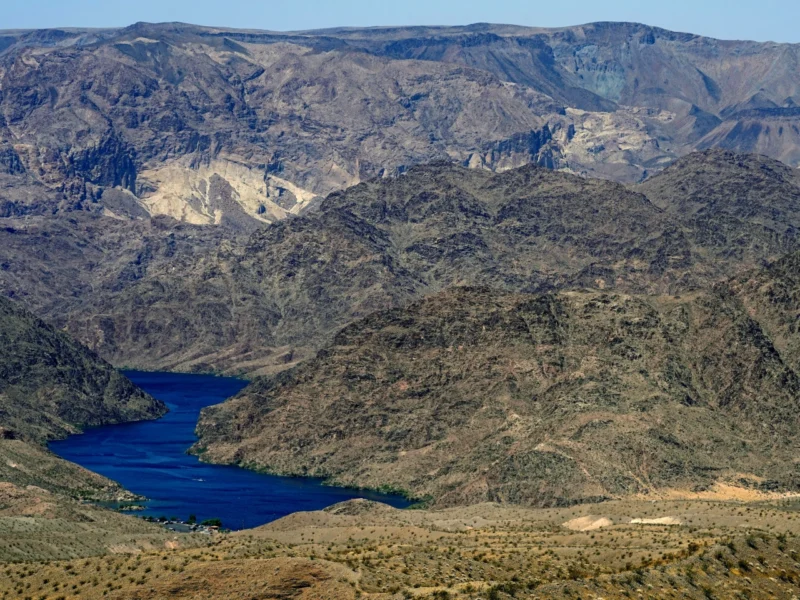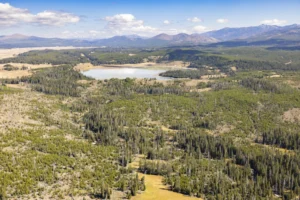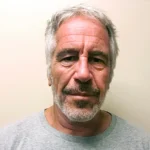States in Colorado River Basin Pitch New Ways to Absorb Shortages but Clash on the Approach
- Published In: Other News & Features
- Last Updated: Mar 07, 2024

The Colorado River cuts through Black Canyon, June 6, 2023, near White Hills, Ariz. The seven U.S. states that draw water from the Colorado River basin are suggesting new ways to determine how the increasingly scarce resource is divvied up when the river can’t provide what it historically promised. (AP Photo/Matt York, File)
BY AMY TAXIN AND BRITTANY PETERSON
SANTA ANA, Calif. (AP) — The seven U.S. states that draw water from the Colorado River basin are suggesting new ways to determine how the increasingly scarce resource is divvied up when the river can’t provide what it historically promised.
The Upper Basin and the Lower Basin states, as neighbors, don’t agree on the approach.
Under a proposal released Wednesday by Arizona, California and Nevada, the water level at Lake Mead — one of the two largest of the Colorado River reservoirs — no longer would determine the extent of water cuts like it currently does. The three Lower Basin states also want what they say is a more equitable way of distributing cuts that would be a 50-50 split between the basins once a threshold is hit.
“This is not a problem that is caused by one sector, by one state, by one basin. It is a basin-wide problem, and it requires a basin-wide solution,” John Entsminger, general manager of the Southern Nevada Water Authority, told reporters Wednesday.
The Upper Basin states of Wyoming, Colorado, New Mexico and Utah submitted their own proposal Tuesday to the U.S. Bureau of Reclamation. It includes addressing water shortages based on the combined capacity of Lake Mead and Lake Powell upstream, instead of the more expansive reservoir system suggested by the Lower Basin. The shortages would trigger various levels of cuts for the Lower Basin.
The Upper Basin proposal also shifts the timing of announcements for any reductions from August predictions for the following January to actual conditions on Oct. 1, the start of the water year. Lower Basin water users typically put in orders for water in mid-October.
The disagreement between the basins isn’t new. Reaching a consensus among the states around managing water has never been easy, but it is the ultimate goal.
“The challenges are complex, and given the short amount of time for an initial submittal, it was not possible to reach a seven-state consensus on an alternative at this time,” said Becky Mitchell, Colorado’s representative to the Upper Colorado River Commission.
Federal officials say there’s no immediate threat that the river that serves more than 40 million people can’t provide water or produce power. On Tuesday, federal officials credited that to agreements reached across the basin to conserve water and shore up Lake Mead. The Biden administration has spent more than $670 million so far on two dozen conservation projects.
The two basins’ proposals signaled a growing commitment to conserve but failed to fully address needs beyond water delivery, including hydropower and ensuring there is sufficient water to maintain a healthy, living river, said John Berggren of Western Resource Advocates, a climate nonprofit.
“I don’t think either presents a holistic, comprehensive package to really address sustainability in the Colorado River basin,” he said.
The current rules and guidelines for managing the river expire at the end of 2026. Reclamation will take the states’ proposals and consider them in finalizing a plan that’s on track to be released in early 2026.
The Colorado River has been in crisis because of a multi-decade drought in the West intensified by climate change, rising demand and overuse. The 1,450-mile (2,334-kilometer) river also serves Mexico and more than two dozen Native American tribes, produces hydropower, and supplies water to farms that grow most of the nation’s winter vegetables.
A century-old compact set aside 7.5 million acre-feet of water annually for each basin that is further doled out based on a priority system. An additional 1.5 million acre-feet is set aside for Mexico, where what remains of the heavily tapped river trickles into the Sea of Cortez. Current inflows average just 14.8 million acre-feet of water, about 15% less than what was apportioned on paper.
When the river can’t provide, states are forced to take less. Arizona and Nevada, as the junior users in the Lower Basin, have absorbed cuts the past two years, as has Mexico.
The Upper Basin states say they’re at the mercy of Mother Nature and generally don’t use their full apportionment because of poor hydrology and, therefore, shouldn’t be subject to mandatory cuts.
“Upper Division states and our water users live within the means of what the river provides every single year,” said Amy Ostdiek, with the Colorado Water Conservation Board.
The Lower Basin relies on snowmelt and storage held at Lake Powell and Lake Mead, which serve as barometers of the river’s health, for water deliveries.
The Lower Basin states are imploring Reclamation to take a more expansive view of river management and factor in other system reservoirs that, together, could hold 58 million acre-feet of water. An acre-foot serves roughly two to three U.S. households per year.
They are proposing that once the system drops below 58% of capacity, the Lower Basin would shoulder 1.5 million acre-feet in cuts. If the system falls to 38% of capacity, additional cuts should be evenly split between the upper and lower basins, they said.
The Lower Basin states want the plan to last until 2060, arguing a need to give certainty to users so they can make long-term investments in water-saving infrastructure, Entsminger said. The Upper Basin is arguing for a much shorter time frame.
In years past, the Lower Basin states butted heads on water reductions but presented a united front Wednesday. Officials from those states said they want their counterparts in the Upper Basin to make more firm commitments to share in protecting the river’s health.
“We are trying to take a compromise position in the Lower Basin and we’d like to see the same out of the Upper Basin,” said JB Hamby, chairman of the Colorado River Board of California.
___
Peterson reported from Denver. Associated Press writer Suman Naishadham in Washington contributed to this report. The Associated Press receives support from the Walton Family Foundation for coverage of water and environmental policy. The AP is solely responsible for all content.
For all of AP’s environmental coverage, visit https://apnews.com/hub/climate-and-environment













